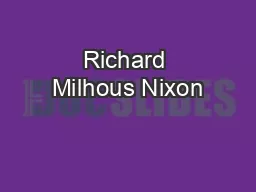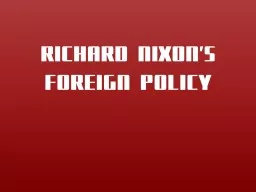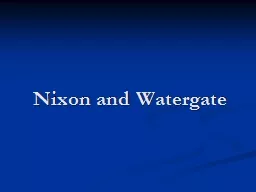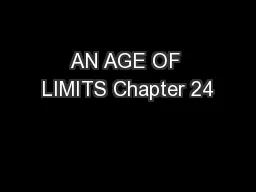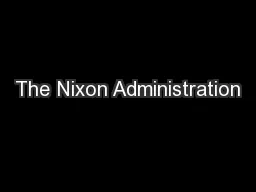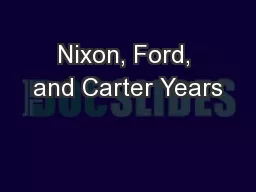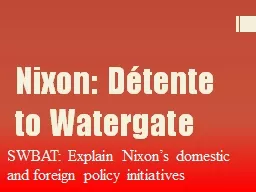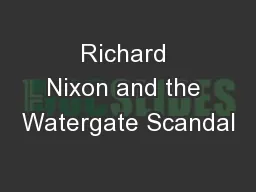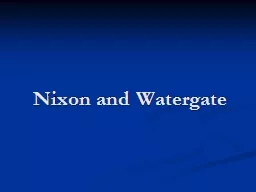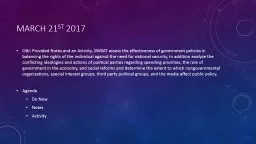PPT-Ford/Nixon
Author : trish-goza | Published Date : 2017-01-12
By Sky P Noah S Brittany VA Vanessa Z Questions What was the longstanding impact of Nixons economic policies What was Nixons general attitude towards Communistallied
Presentation Embed Code
Download Presentation
Download Presentation The PPT/PDF document "Ford/Nixon" is the property of its rightful owner. Permission is granted to download and print the materials on this website for personal, non-commercial use only, and to display it on your personal computer provided you do not modify the materials and that you retain all copyright notices contained in the materials. By downloading content from our website, you accept the terms of this agreement.
Ford/Nixon: Transcript
By Sky P Noah S Brittany VA Vanessa Z Questions What was the longstanding impact of Nixons economic policies What was Nixons general attitude towards Communistallied countries during the Cold War . FOREIGN POLICY. Advance organizer. Richard Nixon rose through the political ranks as a staunch anti-communist; however, the policy of his predecessors brought the world to the brink of nuclear war and brought the U.S. into an expensive and increasingly unpopular war.. What earned Nixon the Right to be President?. Schooling and WWII. Whittier College then Duke University Law School before . Moved to Washington D.C.. Starting practicing law. World War II, Nixon served as a Navy lieutenant commander in the Pacific. 2017 Ford Expedition ford.comLimited in Ruby Red Metallic Tinted Clearcoat with Limited Appearance Package and available equipment. Expedition 4x2. Actual mileage will vary.ACCELERATION BECOMES EXHILA FOREIGN POLICY. Advance organizer. Richard Nixon rose through the political ranks as a staunch anti-communist; however, the policy of his predecessors brought the world to the brink of nuclear war and brought the U.S. into an expensive and increasingly unpopular war.. The Election of 1968. Richard Nixon only narrowly won the 1968 election, but the combined total of popular votes for Nixon and Wallace indicated a shift to the right in American politics. . The 1960's began as an era of optimism and possibility and ended in disunity and distrust. . Subtitle. Nixon (1968-74) . Nixon wins the 1968 presidential election due to a rise of conservatism. Runs on the platform that he will get the U.S. out of the highly unpopular Vietnam War and “return us to law and order”. The Nixon Administration. Section 1. President Richard M. Nixon wanted to turn the U.S. in a more conservative direction.. He tried to decrease the power of the federal government. . Nixon’s plan was called . and . its . impact. Today’s Objective. After today’s lesson, students will be able to…. Explain how President Ford’s decision to pardon Richard Nixon impacted the Ford administration and the American public’s view of the government. Modern American History. The Election of 1968. Richard M. Nixon [R]. Hubert Humphrey [D]. The Election of 1968. Nixon . [. R]. Humphrey [D]. Wallace [AI]. VP for Eisenhower. Aimed at “Middle America”. The Nixon Administration. Nixon’s New Conservatism. 1968- Entered in the Presidency. Wanted to lead the nation in a conservative direction.. New Federalism. Distribute a portion of federal power to state and local governments.. SWBAT: Explain Nixon’s domestic and foreign policy initiatives. Do Now. Identify examples of . both. conflict/hostility and peaceful relations between the U.S. and Soviet Union during the Cold War. Early Life . Richard Milhous Nixon was born on January 9, 1913 in Yorba Linda, California. Nixon lived a very modest childhood, having lived in on a small family ranch in Yorba Linda, California for his early years until 1922 when his family ranch failed and they moved to Whittier, California. Richard Nixon only narrowly won the 1968 election, but the combined total of popular votes for Nixon and Wallace indicated a shift to the right in American politics. . Daniel Ellsberg and the Pentagon Papers . Agenda. Do Now. Notes. Activity . Do Now. What is going on in this clip?. Why do they relate this to Nixon/ Watergate?. Do you think it is relatable? Why or why not?. https://www.youtube.com/watch?v=ixOguUCVp8k.
Download Document
Here is the link to download the presentation.
"Ford/Nixon"The content belongs to its owner. You may download and print it for personal use, without modification, and keep all copyright notices. By downloading, you agree to these terms.
Related Documents


